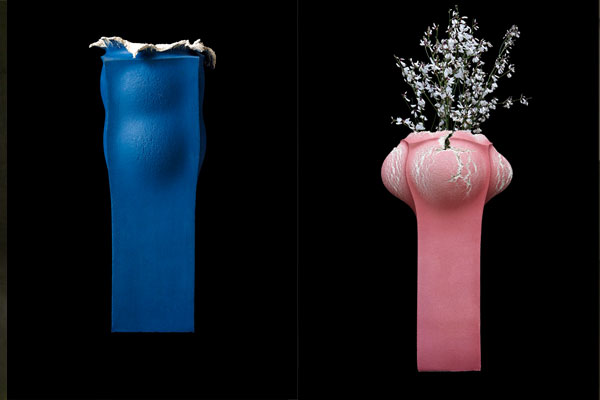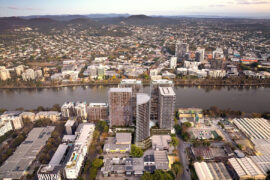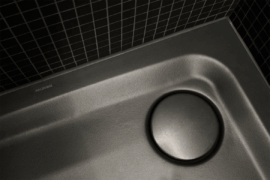LDF 2014 was all about the installations – from five-tonne rotating mirrors in the V&A’s Raphael Gallery to vacuum packed guests at designjunction. Mandi Keighran explores.

October 3rd, 2014
London Design Festival (LDF) is no Salone – the annual design mecca in Milan at which brands, big and small, clamber to launch thousands of new products – and this is no bad thing. It is, rather, a week of conceptual and experimental products and installations by established and emerging designers – and it offers designers the opportunity to fully explore ideas and push concepts to their limit. It is for this reason that LDF remains one of the most important design festivals in the world.
The Victoria & Albert Museum is always a sure bet at LDF, and this year was no exception.
Above: Double Space installation by Barber Osgerby
Barber Osgerby’s Double Space installation in the Raphael Gallery, sponsored by BMW, comprised two gravity-defying rotating mirrored ‘wings’ that weighed five tonnes each and reflected and distorted the exhibited artworks; Zaha Hadid’s aluminium Crest bridge in the John Madejski Garden, commissioned by Spanish hotel group ME by Meliá, also played with reflections.
Above: Crest bridge by Zaha Hadid
And the Candela installation by a group of designers, including Felix de Pass and Michael Montgomery, illuminated the Tapestry Gallery with a spinning disc covered in psychedelic ever-changing luminous patterns.
Above: Candela
Designjunction was once again a mixed bag. Although there were a number of strong conceptual installations and new products on show, they were somewhat lost amidst what was, overall, an underwhelming exhibition. Highlights included Australian designer Lucy McRae’s human vacuum chamber as part of the Dezeen and MINI Frontiers exhibition and Vitamin’s terracotta K Lamp.
Above: Human Vacuum Chamber by Lucy McRae
Above: Terracotta K Lamp by Vitamin
The Teddy’s Wish exhibition also stood out, at which leading UK designers, including Benjamin Hubert, Faye Toogood and Tom Dixon, customised Anglepoise lamps and Ercol chairs to be auctioned off to raise funds for research into SIDS; there was also a strong talks program, which featured star designers and reports from international design programs alongside practical seminars on topics such as protecting intellectual property.
Above: Teddy’s Wish exhibition
Pop-ups proved popular for yet another year, with several located in high-profile destinations. Airbnb sponsored A Place Called Home in Trafalgar Square, for which Jasper Morrison, Ilse Crawford, Raw Edges and Patternity interpreted the concept of ‘home’ in four house-shaped pavilions.
Above: A Place Called Home
In keeping with the central London location, Jasper Morrison designed a home for a pigeon keeper, while Raw Edges’ interior was a study into small spaces featuring sliding partitions and folding furniture. Over in Soho, architect Amanda Levete of AL_A debuted a six-month pop-up restaurant that elevates tinned seafood and features a delightfully graphic window display.
Mint Gallery in West London hosted an exhibition titled Elements of Craft, which showcased over 30 works by emerging designers exploring material and process. One of the most interesting projects here was Booming Vases by Analogia Project in collaboration with Alesso Sarri, a collection of vases created by detonating gunpowder-filled wet-clay forms.
Above: Booming Vases by Analogia Project in collaboration with Alesso Sarri
Back in North-East London, the Established & Sons showroom was taken over by Formafantasma, who created a range of unusual time-keeping devices. Here, saxophones, marble discs, a metal fan and a brass brush were used to mark the passing of time in various ways, prompting viewers to consider the way we interpret time.
Above: Formafantasma
The Old Truman Brewery again played host to TENT, where the highlights were Sebastian Cox’s Underwood collection of furniture and accessories made from foraged hazel wood, and the 100% Norway exhibition, which represented every stage of a design career, from graduate to established professional.
Above: Vera Kyte Salone Satellite Collection

And, down the road, at the heart of the Shoreditch Design Triangle, the Ace Hotel transformed the ground floor into the pop-up Extra-Ordinary Gallery, curated by Fabrica and Modern Design Review, with work by Bethan Laura Wood, Max Lamb and Martino Gamper.
Above: Made in Ratio
Not all the spaces at LDF were temporary, however. Wrong for Hay launched a new showroom at Queen Anne’s Gate, and London-based Australian designer Brodie Neill opened the first showroom for his Made in Ratio brand in Shoreditch.
With each year, LDF grows bigger and better, as evidenced this year by the plethora of installations and spaces supported by big brands – from MINI and BMW to Airbnb, ME by Meliá and Harrods. And, as the festival expands, so does its audience and, in turn, a general awareness of design in the UK capital.
Mandi Keighran is Editor-at-large for Indesign, based in London.
INDESIGN is on instagram
Follow @indesignlive
A searchable and comprehensive guide for specifying leading products and their suppliers
Keep up to date with the latest and greatest from our industry BFF's!

London-based design duo Raw Edges have joined forces with Established & Sons and Tongue & Groove to introduce Wall to Wall – a hand-stained, “living collection” that transforms parquet flooring into a canvas of colour, pattern, and possibility.
The new range features slabs with warm, earthy palettes that lend a sense of organic luxury to every space.
Your comfort and wellbeing is one of the most important aspects in any workplace. For this reason, Signature Floorcoverings developed Comfi BAK stock carpet tiles. A unique cushioning system, which provides extra comfort underfoot for carpet tiles.
Already a favourite within the B&B range, Naoto Fukasawa’s Papilio Collection now offers even more to love
The internet never sleeps! Here's the stuff you might have missed

Plus Studio and ICD Property have submitted a proposal for a development on Brisbane’s Donkin Street, using a 1.68-hectare former industrial site as a new riverside residential and community destination.

Overlooking Berlin Zoo, the suites of the 25hours Hotel Bikini Berlin curate the sustainability ethos in an entirely unique and dynamic aesthetic. Think natural fabrics and materials, jewel-hued colours, curves and cushions, spa-like bathrooms and hammocks with views over urban greenery.